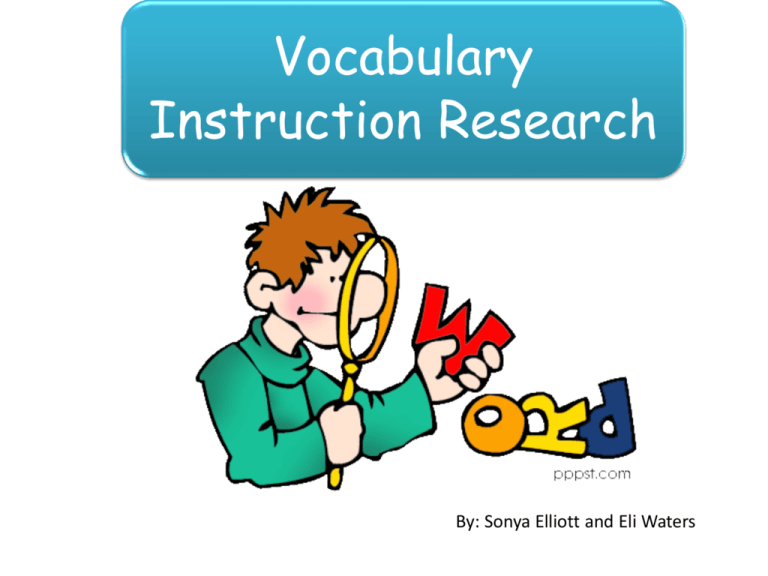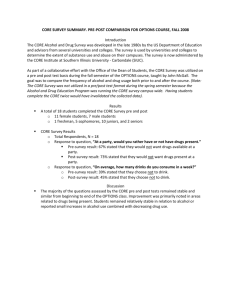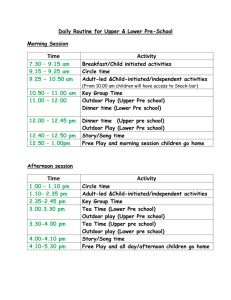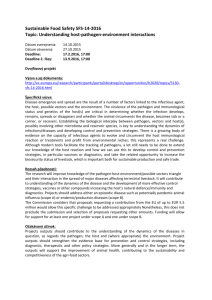RE 5040 Research presentation
advertisement

Vocabulary Instruction Research By: Sonya Elliott and Eli Waters Background Information: Students struggle with varying aspects of reading comprehension Vocabulary comprehension was not mastered in lower grades, therefore students came into our classrooms without adequate vocabulary to comprehend text Students expressed concern over being taught numerous “vocabulary” words for spelling each week without ever examining the meaning Research: McKeown,M.G., and I.L. Beck. “Direct and Rich Vocabulary Instruction.” Vocabulary Instruction. 2004 R. Malatesha Joshi.”Vocabulary: A Critical Component of Comprehension.” Reading & Writing Quarterly, 21:209219, 2005 Lu Mei-fang. “Teachers’ role in vocabulary teaching: Strategies for vocabulary teaching.” Sino-US English Teaching 5, no. 8 (2008): 1-6. Journal of Adolescent & Adult Literacy : November 2007 : Abstract of Effective Content Vocabulary Instruction in the Middle: Matching Students, Purposes, Words, and Strategies”, n.d. zotero://attachment/24/. Research Con’t: Flanigan, Kevin, and Scott C. Greenwood. “Effective Content Vocabulary Instruction in the Middle: Matching Students, Purposes, Words, and Strategies.” Journal of Adolescent & Adult Literacy 51, no. 3 (2007): 226-238. Boulware-Gooden, Regina, Suzanne Carreker, Ann Thornhill, and R. Malatesha Joshi. “Instruction of Metacognitive Strategies Enhances Reading Comprehension and Vocabulary Achievement of Third-Grade Students.” The Reading Teacher 61, no. 1 (2007): 70-77. Atkinson, Fairlie. “Improving Reading Comprehension Through Instructional Vocabulary Strategies.” Perspectives (TESOL Arabia) 17, no. 2 (June 2010): 15-19. What are the effects of an integrated direct and indirect vocabulary instructional approach on vocabulary growth? The Questions: What are the effects of a meaning-based vocabulary instructional approach on vocabulary growth? Classroom Demographics Grade • Eli’s Classroom • Sonya’s Classroom • 7th • 5th Grade • 15 male Gender • 13 female • 12 male Gender • 13 female • 1/3 Caucasian Ethnicity • Growing Hmong population • 3/4 Caucasian Ethnicity • 2 African American and 2 Hispanic Ability • Regular education classroom with multiple ability levels Ratio • Regular education classroom with multiple ability levels Morphemic root introduction Word meaning from context Word Journals Instructional plan Pre and Post vocabulary test Examples of student work A: Examples of student work B: Examples of student work C: Examples of student work D: Examples of student work E: Word Journal Entries Morphemic root pre/post test Pre and Post Assessment Scores Writing samples Mrs. Elliott’s Pre and Post Vocabulary Data Students: 1 2 3 4 5 Week 1 Pre Week 1 Post Gain/Loss Week 2 Pre Week 2 Post Gain/Loss Week 3 Pre Week 3 Post Gain/Loss Week 4 Pre Week 4 Post Gain/Loss 0 71 +71 40 84 +44 0 100 +100 20 88 +68 0 68 +68 0 70 +70 20 100 +80 0 100 +100 20 18 -2 20 86 +66 0 100 +100 40 94 +54 20 80 +60 40 74 +34 40 100 +60 20 91 +71 0 92 +92 40 97 +57 40 90 +50 60 100 +40 Overall Gain/Loss +70 +79 +54 +56 +59 Mrs. Elliott’s Pre and Post Test Data Mr.Water’s Pre and Post Vocabulary Data 1 2 3 4 5 Week 1 Pre Week 1 Post Gain/Loss Week 2 Pre Week 2 Post Gain/Loss Week 3 Pre Week 3 Post Gain/Loss Week 4 Pre Week 4 Post Gain/Loss 14 29 +15 25 0 -25 33 100 +67 50 25 -25 14 100 +86 38 100 +62 17 67 +50 63 38 -25 57 100 +43 25 100 +75 50 100 +50 38 50 +12 43 100 +57 38 100 +62 17 100 +83 25 50 +25 71 100 +29 38 100 +62 67 100 +33 50 63 +13 Overall Gain/Loss +8 +43 +45 +57 +34 Mr. Water’s Pre and Post Test Data




